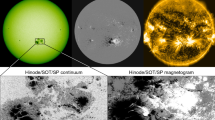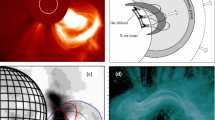Abstract
We study the effect of new emerging solar active regions on the large-scale magnetic environment of existing regions. We first present a theoretical approach to quantify the “interaction energy” between new and pre-existing regions as the difference between i) the summed magnetic energies of their individual potential fields and ii) the energy of their superposed potential fields. We expect that this interaction energy can, depending upon the relative arrangements of newly emerged and pre-existing magnetic flux, indicate the existence of “topological” free magnetic energy in the global coronal field that is independent of any “internal” free magnetic energy due to coronal electric currents flowing within the newly emerged and pre-existing flux systems. We then examine the interaction energy in two well-studied cases of flux emergence, but find that the predicted energetic perturbation is relatively small compared to energies released in large solar flares. Next, we present an observational study of the influence of the emergence of new active regions on flare statistics in pre-existing active regions, using NOAA’s Solar Region Summary and GOES flare databases. As part of an effort to precisely determine the emergence time of active regions in a large event sample, we find that emergence in about half of these regions exhibits a two-stage behavior, with an initial gradual phase followed by a more rapid phase. Regarding flaring, we find that the emergence of new regions is associated with a significant increase in the occurrence rate of X- and M-class flares in pre-existing regions. This effect tends to be more significant when pre-existing and new emerging active regions are closer. Given the relative weakness of the interaction energy, this effect suggests that perturbations in the large-scale magnetic field, such as topology changes invoked in the “breakout” model of coronal mass ejections, might play a significant role in the occurrence of some flares.









Similar content being viewed by others
Notes
At http://www.lmsal.com/solarsoft/pfss_links/ or via the PFSS_VIEWER interface in SSWIDL if this URL is no longer valid.
These reports are online; see ftp://ftp.swpc.noaa.gov/pub/warehouse/README .
References
Altschuler, M.D., Newkirk, G.: 1969, Magnetic fields and the structure of the solar corona. Solar Phys. 9, 131.
Antiochos, S.K., DeVore, C.R., Klimchuk, J.A.: 1999, A model for solar coronal mass ejections. Astrophys. J. 510, 485.
Balasubramaniam, K.S., Pevtsov, A.A., Cliver, E.W., Martin, S.F., Panasenco, O.: 2011, The disappearing solar filament of 2003 June 11: a three-body problem. Astrophys. J. 743, 202. DOI .
Bruzek, A.: 1952, Über die Ursache der “Plötzlichen” Filamentauflösungen. Mit 4 Textabbildungen. Z. Astrophys. 31, 99.
Bumba, V., Howard, R.: 1965, Large-scale distribution of solar magnetic fields. Astrophys. J. 141, 1502. DOI .
Cheung, M.C.M., DeRosa, M.L.: 2012, A method for data-driven simulations of evolving solar active regions. Astrophys. J. 757, 147. DOI .
Chintzoglou, G., Zhang, J.: 2013, Reconstructing the subsurface three-dimensional magnetic structure of a solar active region using SDO/HMI observations. Astrophys. J. Lett. 764, L3. DOI .
Dalla, S., Fletcher, L., Walton, N.A.: 2007, Flare productivity of newly-emerged paired and isolated solar active regions. Astron. Astrophys. 468, 1103. DOI .
Dalla, S., Fletcher, L., Walton, N.A.: 2008, Invisible sunspots and rate of solar magnetic flux emergence. Astron. Astrophys. 479, L1. DOI .
Dove, J.B., Gibson, S.E., Rachmeler, L.A., Tomczyk, S., Judge, P.: 2011, A ring of polarized light: evidence for twisted coronal magnetism in cavities. Astrophys. J. Lett. 731, L1. DOI .
Emslie, A.G., Dennis, B.R., Shih, A.Y., Chamberlin, P.C., Mewaldt, R.A., Moore, C.S., Share, G.H., Vourlidas, A., Welsch, B.T.: 2012, Global energetics of thirty-eight large solar eruptive events. Astrophys. J. 759, 71. DOI .
Feynman, J., Martin, S.F.: 1995, The initiation of coronal mass ejections by newly emerging magnetic flux. J. Geophys. Res. 100, 3355. DOI .
Fisher, G.H., Longcope, D.W., Metcalf, T.R., Pevtsov, A.A.: 1998, Coronal heating in active regions as a function of global magnetic variables. Astrophys. J. 508, 885.
Fludra, A., Ireland, J.: 2008, Radiative and magnetic properties of solar active regions. I. Global magnetic field and EUV line intensities. Astron. Astrophys. 483, 609. DOI .
Forbes, T.G.: 2000, A review on the genesis of coronal mass ejections. J. Geophys. Res. 105, 23153.
Freeland, S.L., Handy, B.N.: 1998, Data analysis with the SolarSoft system. Solar Phys. 182, 497. DOI .
Georgoulis, M.K., Titov, V.S., Mikić, Z.: 2012, Non-neutralized electric current patterns in solar active regions: origin of the shear-generating Lorentz force. Astrophys. J. 761, 61. DOI .
González Hernández, I., Hill, F., Lindsey, C.: 2007, Calibration of seismic signatures of active regions on the far side of the Sun. Astrophys. J. 669, 1382. DOI .
Harvey, K.L., Zwaan, C.: 1993, Properties and emergence of bipolar active regions. Solar Phys. 148, 85.
Heyvarts, J., Priest, E.R., Rust, D.M.: 1977, An emerging flux model for the solar flare phenoma. Astrophys. J. 216, 123.
Hudson, H., Fletcher, L., McTiernan, J.: 2014, Cycle 23 variation in solar flare productivity. Solar Phys. 289, 1341. DOI .
Kazachenko, M.D., Canfield, R.C., Longcope, D.W., Qiu, J.: 2010, Sunspot rotation, flare energetics, and flux rope helicity: the halloween flare on 2003 October 28. Astrophys. J. 722, 1539. DOI .
Leka, K.D., Barnes, G.: 2003, Photospheric magnetic field properties of flaring versus flare-quiet active regions. I. Data, general approach, and sample results. Astrophys. J. 595, 1277.
Leka, K.D., Canfield, R.C., McClymont, A.N., van Driel Gesztelyi, L.: 1996, Evidence for current-carrying emerging flux. Astrophys. J. 462, 547.
Leka, K.D., Barnes, G., Birch, A.C., Gonzalez-Hernandez, I., Dunn, T., Javornik, B., Braun, D.C.: 2013, Helioseismology of pre-emerging active regions. I. Overview, data, and target selection criteria. Astrophys. J. 762, 130. DOI .
Liewer, P.C., González Hernández, I., Hall, J.R., Lindsey, C., Lin, X.: 2014, Testing the reliability of predictions of far-side active regions from helioseismology using STEREO far-side observations of solar activity. Solar Phys. 289, 3617. DOI .
Liggett, M., Zirin, H.: 1985, Emerging flux in active regions. Solar Phys. 97, 51. DOI .
Longcope, D.W., McKenzie, D., Cirtain, J., Scott, J.: 2005, Observations of separator reconnection to an emerging active region. Astrophys. J. 630, 596.
Luhmann, J.G., Li, Y., Zhao, X., Yashiro, S.: 2003, Coronal Magnetic Field Context of Simple CMEs Inferred from Global Potential Field Models. Solar Phys. 213, 367. DOI .
Mallman, E.P., Parsons, T.: 2008, A global search for stress shadows. J. Geophys. Res. 113, 12304. DOI .
Martin, S.F.: 1998, Conditions for the formation and maintenance of filaments – (invited review). Solar Phys. 182, 107.
Martin, S.F., Dezso, L., Antalova, A., Kucera, A., Harvey, K.L.: 1982, Emerging magnetic flux, flares and filaments – FBS interval 16 – 23 June 1980. Adv. Space Res. 2, 39. DOI .
McClymont, A.N., Fisher, G.H.: 1989, On the mechanical energy available to drive solar flares. AGU Geophys. Mon. Ser. 54, 219.
Moon, Y.J., Choe, G.S., Park, Y.D., Wang, H., Gallagher, P.T., Chae, J., Yun, H.S., Goode, P.R.: 2002, Statistical evidence for sympathetic flares. Astrophys. J. 574, 434. DOI .
Pevtsov, A.A.: 2000, Transequatorial loops in the solar corona. Astrophys. J. 531, 553. DOI .
Pevtsov, A.A., Kazachenko, M.: 2004, On the role of the large-scale magnetic reconnection in the coronal heating. In: Walsh, R.W., Ireland, J., Danesy, D., Fleck, B. (eds.) SOHO 15 Coronal Heating, ESA SP-575, 241.
Priest, E.: 2014, Magnetohydrodynamics of the Sun, Cambridge University Press, Cambridge.
Scherrer, P.H., Schou, J., Bush, R.I., Kosovichev, A.G., Bogart, R.S., Hoeksema, J.T., Liu, Y., Duvall, T.L., Zhao, J., Title, A.M., Schrijver, C.J., Tarbell, T.D., Tomczyk, S.: 2012, The Helioseismic and Magnetic Imager (HMI) investigation for the Solar Dynamics Observatory (SDO). Solar Phys. 275, 207. DOI .
Scherrer, P., Bogart, R.S., Bush, R.I., Hoeksema, J.T., Kosovichev, A., Schou, J., Rosenberg, W., Springer, L., Tarbell, T., Title, A., Wolfson, C., Zayer, I., The MDI Engineering Team: 1995, The solar oscillations investigation – Michelson Doppler imager. Solar Phys. 162, 129.
Schou, J., Scherrer, P.H., Bush, R.I., Wachter, R., Couvidat, S., Rabello-Soares, M.C., Bogart, R.S., Hoeksema, J.T., Liu, Y., Duvall, T.L., Akin, D.J., Allard, B.A., Miles, J.W., Rairden, R., Shine, R.A., Tarbell, T.D., Title, A.M., Wolfson, C.J., Elmore, D.F., Norton, A.A., Tomczyk, S.: 2012, Design and ground calibration of the Helioseismic and Magnetic Imager (HMI) instrument on the Solar Dynamics Observatory (SDO). Solar Phys. 275, 229. DOI .
Schrijver, C.J., DeRosa, M.L.: 2003, Photospheric and heliospheric magnetic fields. Solar Phys. 212, 165.
Schrijver, C.J., Higgins, P.A.: 2015, A Statistical Study of Distant Consequences of Large Solar Energetic Events. Solar Phys. 290, 2943. DOI .
Schrijver, C.J., Title, A.M.: 2011, Long-range magnetic couplings between solar flares and coronal mass ejections observed by SDO and STEREO. J. Geophys. Res. 116, 4108. DOI .
Schrijver, C.J., Zwaan, C.: 2000, Solar and Stellar Magnetic Activity, Cambridge University Press, Cambridge.
Schrijver, C.J., DeRosa, M.L., Title, A.M., Metcalf, T.R.: 2005, The nonpotentiality of active-region coronae and the dynamics of the photospheric magnetic field. Astrophys. J. 628, 501.
Sun, X., Hoeksema, J.T., Liu, Y., Wiegelmann, T., Hayashi, K., Chen, Q., Thalmann, J.: 2012, Evolution of magnetic field and energy in a major eruptive active region based on SDO/HMI observation. Astrophys. J. 748, 77. DOI .
Tarr, L., Longcope, D.: 2012, Calculating energy storage due to topological changes in emerging active region NOAA AR 11112. Astrophys. J. 749, 64. DOI .
Tarr, L.A., Longcope, D.W., McKenzie, D.E., Yoshimura, K.: 2014, Quiescent reconnection rate between emerging active regions and preexisting field, with associated heating: NOAA AR 11112. Solar Phys. 289, 3331. DOI .
Toriumi, S., Yokoyama, T.: 2011, Numerical experiments on the two-step emergence of twisted magnetic flux tubes in the Sun. Astrophys. J. 735, 126. DOI .
Török, T., Leake, J.E., Titov, V.S., Archontis, V., Mikić, Z., Linton, M.G., Dalmasse, K., Aulanier, G., Kliem, B.: 2014, Distribution of electric currents in solar active regions. Astrophys. J. Lett. 782, L10. DOI .
Wang, Y.M., Sheeley, N.R. Jr.: 1999, Filament eruptions near emerging bipoles. Astrophys. J. Lett. 510, L157. DOI .
Watson, F., Fletcher, L., Dalla, S., Marshall, S.: 2009, Modelling the longitudinal asymmetry in sunspot emergence: the role of the Wilson depression. Solar Phys. 260, 5. DOI .
Welsch, B.T.: 2006, Magnetic flux cancellation and coronal magnetic energy. Astrophys. J. 638, 1101.
Wheatland, M.S.: 2001, Rates of flaring in individual active regions. Solar Phys. 203, 87. DOI .
Yeates, A.R., Mackay, D.H., van Ballegooijen, A.A.: 2008, Modelling the global solar corona II: coronal evolution and filament chirality comparison. Solar Phys. 247, 103. DOI .
Acknowledgements
We thank the referee for providing a detailed review of our manuscript, and for valuable suggestions to improve it, including the suggestion of super-active-region connections within the solar interior. We thank the American taxpayers for supporting this work. We are also grateful to Hugh Hudson, Mike Wheatland, and Silvia Dalla for reading a draft of this paper, and offering suggestions that improved it. We acknowledge funding from the NSF’s National Space Weather Program under award AGS-1024862, the NASA Heliophysics Theory Program (grant NNX11AJ65G), and the Coronal Global Evolutionary Model (CGEM) award NSF AGS 1321474.
Author information
Authors and Affiliations
Corresponding author
Rights and permissions
About this article
Cite this article
Fu, Y., Welsch, B.T. Active Region Emergence and Remote Flares. Sol Phys 291, 383–410 (2016). https://doi.org/10.1007/s11207-016-0851-z
Received:
Accepted:
Published:
Issue Date:
DOI: https://doi.org/10.1007/s11207-016-0851-z




